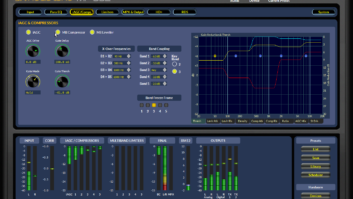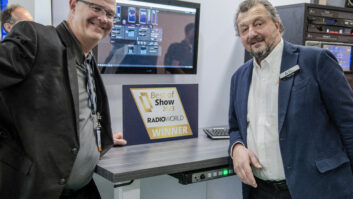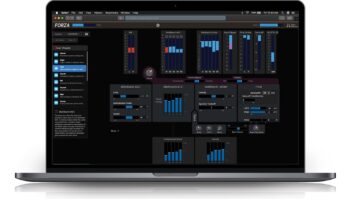Audio Processing Update
Oct 1, 2012 2:20 PM, By Doug Irwin, CPBE DRB AMD
We spend a lot of time talking about the newer technologies being put to use in a radio station, but the fact of the matter is that the vast majority of our listeners still use analog radios to hear us. For that reason it’s worthwhile discussing air-chain audio processing – the last device ahead of the transmitter.
Instead of rehashing all the standard features, I want to emphasize what makes the different devices from various manufacturers unique. At the end of this article I’ll discuss comparison techniques that you can use to help decide which processor makes the most sense for your station. You can’t base your decision on price and features alone – how the device sounds over the air should also factor into your decision.
For on-air processing, devices will have these features as standard:
� Analog and AES inputs
� Wideband automatic gain control (AGC)
� Multiband AGC
� Multiband limiting
� Clipping
� Analog and AES outputs
� Processing presets developed by the equipment designers
� Full remote access to front panel controls (and often more) via Ethernet
These are the standard features we’ve come to expect from this sort of device. On-air processors for FM will of course include a stereo generator and composite outputs.
Omnia.11

Omnia.11
Omnia is one of the most well known audio processing manufacturers, and the Omnia.11 is the current flagship product in a long line of OTA audio processors. In addition to the standard features, it adds the following features (among others):
� Livewire ins and outs in addition to AES, analog and composite outputs
� Built-in composite low-pass filter to protect RDS/RBDS and SCA signals
� Single rear-panel SCA input
� Parallel processing path for HD, DAB or other lossy-codec streams; has its own final mixer and look-ahead limiting
� Front panel 10.5″ full-color touchscreen GUI
� Embedded Web-browser for remote access
� Up to 20 seconds of built-in diversity delay
� 4RU
Of course probably the most interesting feature of the Omnia.11 is its single sideband suppressed-carrier stereo generator capability (SSBSC). When using this feature, only the lower sidebands (of the suppressed 38kHz carrier) are in composite output. The level of those sidebands in the composite output is increased by 6dB (versus the level of the same sidebands, were the double sideband-suppressed carrier used) so that the overall modulation level stays the same. Your station will need to send an informal letter to the Commission requesting experimental authorization regarding use of SSBSC.
If you don’t want to pay for extra features, there is a non-HD version of the Omnia.11 available as well.
– continued on page 2
Audio Processing Update
Oct 1, 2012 2:20 PM, By Doug Irwin, CPBE DRB AMD
Orban Optimod-FM 8600

Orban Optimod-FM 8600
The current top-of-the-line product from Orban is the Optimod-FM 8600. Among its many features are:
� Active-matrix, color, liquid-crystal display with front-panel joystick for navigation
� Dual processing chains for analog and HD/DAB/lossy-codec outputs
� AGC and stereo enhancement are common, but multiband compression/limiting and peak limiting are independent
� HD Radio audio bandwidth is user adjustable between 15 and 20kHz
� Guaranteed protection of RDS/RBDS/SCA spectrum
� Dual rear-panel SCA inputs
� Integrated line-up tone generation that facilitates level setting
� Up to 16.2 seconds of diversity delay
� Backward compatibility with user-developed processing presets from older Orban processors
� Latest software version provides SSBSC mode in the stereo generator
� Uses 8600 PC Remote software running on user’s PC for remote access
� 3RU
A non-HD version is also available.
Wheatstone AirAura 2.0

Wheatstone AirAura 2.0
Wheatstone is a relative newcomer to the OTA processor market. Its top-of-the-line product is the AirAura 2.0. In addition to the standard features, it has:
� Dual front-panel displays
� 31-band limiter – one set for analog FM, one for HD
� Wheatnet-IP input in addition to standard inputs
� Analyzer functions for input or processed audio: 1024 point FFT, oscilloscope, energy vs. audio frequency
� Dual SCA inputs on rear panel
� Ethernet ports for remote access
� Uses Audio Processing Guru running on user’s PC for remote access
� 3RU
– continued on page 3
Audio Processing Update
Oct 1, 2012 2:20 PM, By Doug Irwin, CPBE DRB AMD
BW Broadcast DSPXtreme-FM/HD

210rad2103
BW Broadcast offers its own line-up of OTA audio processors. In particular, let’s look at the DSPXtreme. In addition to the standard features, it has:
� Two versions available: FM-only and FM+HD with dual processing paths for simultaneous FM and digital radio processing
� Two 3″ front-panel color TFT screens
� 12 seconds of diversity delay
� Stereo encoder with composite clipping control
� Single rear-panel SCA input
� RS-232 and Ethernet ports
� X-Sense GUI runs on user’s PC
� 2RU
Inovonics David IV

Inovonics David IV
Inovonics‘ newest product is the David IV. In addition to the standard features, it also has:
� Front panel graphic display, with jog wheel for navigation
� Remote access via proprietary Windows-based program that runs on a PC
� Composite clipping, up to 3dB in depth
� Low throughput latency to allow for off-air listening
� Single SCA input, rear panel, used for RDS input
� 1RU
Side by side
It’s obvious that the five processors I’ve mentioned are only a small fraction of what is available out there. Each manufacturer has a line-up of various products. I’ve highlighted the top-end of each of their product lines, but they all have less-expensive devices as well. Clearly you’ll have to balance the features you need versus the budget you have to make the purchase.
You can make all sorts of comparisons between the features of brand X vs. brand Y but when it comes right down to it, the selection of an on-air processor should be subjective, not objective. You should listen to the proposed device over the air before making any sort of decision about what to buy, especially since many of these units are quite expensive. What’s the best way to actually do that, though?
The techniques are basically the same for an FM or an AM station. You need three things to make this work:
� Get the loaner (or the evaluation device) from the manufacturer or your favorite broadcast vendor for a reasonable amount of time.
� Get a device that will allow you to switch between evaluation device A and evaluation device B remotely.
� Get access to the remote control that does the actual switching.
I also recommend that evaluation of AM processors be done in an area of weak to moderate signal strength.
– continued on page 4
Audio Processing Update
Oct 1, 2012 2:20 PM, By Doug Irwin, CPBE DRB AMD
For AM you’ll need a device to switch the transmitter input between the two evaluation devices. This could be as simple as a DPDT switch (for analog audio) actuated by a remote control. Make sure there is some sort of status that tells you definitively which device is actually on-air.
For FM, obtain a composite switch, or perhaps build one yourself (SPDT coaxial relay). Again, make sure there is status that allows you to know which one is on-air.
Clearly both test devices should be fed by exactly the same audio source. Peak modulation levels generated by the two devices need to match for a fair test. An oscilloscope is the best instrument for setting peak levels; make sure the evaluation device is actually connected up to its load when setting the levels. (We are striving for accuracy, after all.)
After the setup is done comes the real work. You will need to spend time adjusting device A to your liking, and you’ll need to spend time adjusting device B to your liking. (Quite often one of the two devices will be the legacy unit so most likely it’ll be tweaked-out already.)
There are two primary locations for evaluating the devices: in your vehicle, and on a monaural radio in an office environment. Your vehicle is important not only because of the in-car listening aspect that is so important to radio in general, but also because it’s probably the source of sound you are most familiar with. That familiarity is important because it makes differences in sound from one device to the other easier to pick out. An office environment is also important in the grand scheme of radio; but more specifically, you’ll want to hear the station in mono like so many listeners will. Radios such as these often don’t have a lot of bass response, and they don’t have a lot of high-frequency response, so you’ll probably find the station sounds different on one of these versus a system that has three-way speakers, and good wideband audio response. (The vast majority of listeners don’t hear your station that way.)
When running comparative listening tests between devices, it’s important that, at the very least, you hear all the various sources that get sent out. For an FM music station, that might take a couple of hours, or a couple of days depending upon the format. For a talk station, make sure during the A vs. B evaluation period, you hear all the various voices and production sources.
This is an iterative process; during this A vs. B period, you may decide to do extra tweaking on one or both devices. Use your remote control to switch processors at any time; during speech, during songs, during spots. Listen to the differences between the devices on all sources and at different times (i.e., different jocks or board operators). This is also a great way to compare your stations’ potential new sound to any competitors. I would also caution you not to jump to conclusions too early on. Give it a couple of days at minimum – listen a lot – and after that amount of time it’s likely the winner will have emerged.
As I said before, the decision on what to do with on-air processing should be subjective after you’ve determined what the practical choices are. There isn’t any real point in evaluating the on-air sound that you can get from a device that, ultimately, the station can’t afford.
Irwin is transmission systems supervisor for Clear Channel NYC and chief engineer of WKTU, New York. Contact him at [email protected].
October 2012
Clear Channel Seatlle rebuilds, audio processing update, the Digigram Cancun 222-Mic is reviewed, and we compare nearfield monitors….











